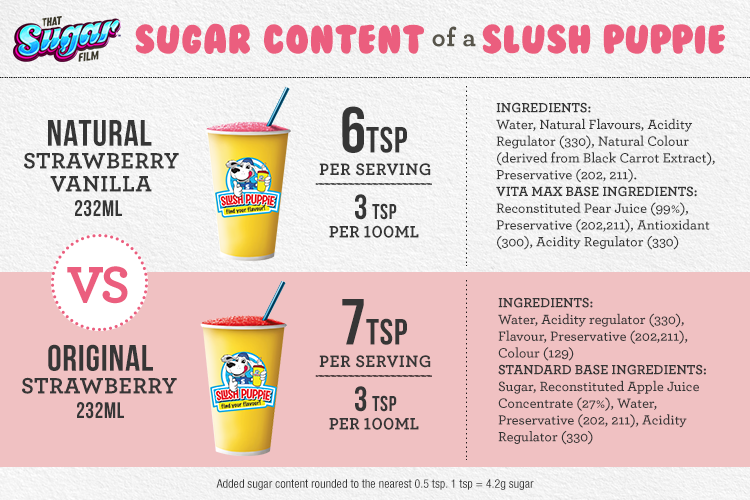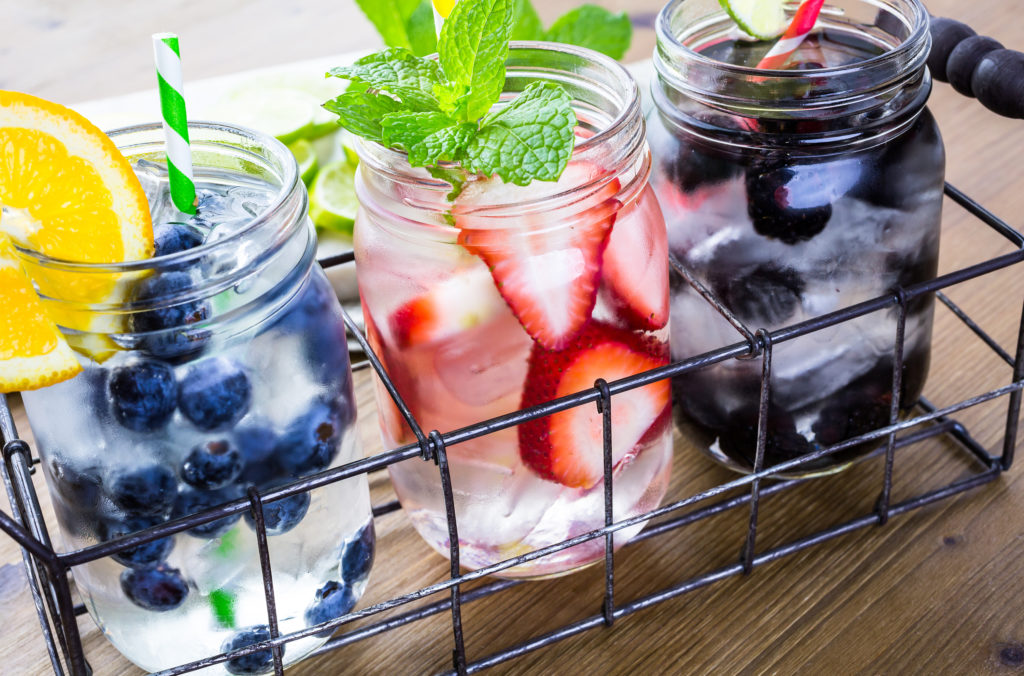Blog
A healthy slushie?
Can it be true? Can it exist? A commercially made healthy slushie? Maybe that depends on what you define as healthy.
Slush puppy, slurpies, slushies, frozen drinks – these typically provide a relief to a scorching summer heat. As desirable as they may seem did you know that:
- A large 7-Eleven Cola Slurpee contains 84g (21 teaspoons), a ‘super’ size contains 115g (29 teaspoons) and a ‘mega’ serving contains 152g (38 teaspoons) of sugar.
- A large Hungry Jack’s Frozen Coke contains 84g (21 teaspoons) and an extra large serve has 120g (30 teaspoons) of sugar
- A McDonald’s Frozen Sprite Splash plus free refill contains 120g (30 teaspoons) of sugar in total (1)
So on average, you may expect to consume 30tsp of sugar, when we are recommended to limit intake to 6tsp. This is equivalent to:
- 2.5L orange juice
- 8 standard Mars bars
- 2L coke.
What is largely concerning is that not only do each of these send the recommended servings well out of the dietary ball park, but are also super cheap to buy.
Fruit based slushies are becoming available in some school tuck shops. Promoted as their natural range, Slush Puppie use a 99% pear juice base, with added flavours on top. It is given an ‘Amber’ rating by the Health Kids Association, meaning it can be used within schools but in a limited capacity. As you can see below, the difference in amount of added sugar is minimal.
Sure, this blend isn’t the same source of sugar as the frozen drinks above, and this is great. But the body receives sugar as sugar, often regardless of source. And according to the WHO, pear juice concentrate falls under the ‘added’ sugar category.(6)
250ml of pear juice can typically comprise 6tsp of sugar. A serve of the natural Slush Puppie (232ml) contains 23g of sugar – approximately 6tsp of sugar. It recommended children up to age 8 limit daily intake to 3-4tsp of sugar. You do the math.
An alternative
Now don’t get us wrong – of course there are options available for ‘heathier’ ice-crush drinks. These may comprise of ice and some whole fruit blended. Great for hot summer’s day!
The difference between this suggestion, and the juice based slush puppy, is the inclusion of the whole fruit within the blend. When we include the fruit in its whole form, we include fibre, and possibly a little protein, which assist in feeling fuller quicker, for longer, and will slow the release of simple sugars into the blood stream. This ultimately supports a gradual and steady stream of energy release, avoiding blood sugar highs and then lows.
Simple sugars and sitting at school
Kids, in general, are brimming with energy. Sitting for extended periods at school may be a struggle at times. However, imagine a child, having knocked back twice the amount of recommended daily limit of added sugar in one hit, having to then sit and concentrate.
Increased intake of fruit juice and soft drink have been seen to decrease academic performance; whilst and high blood sugar levels have been seen to impair cognitive function in those with diabetes. (2,3,4,5)
Not only that, we could be putting our little tackers in to a tough position emotionally. In essence, every kid wants to get along. But when fighting the physical reaction of the body following a high dose sugar slam, they may be reprimanded (which nobody feels good about) for active behaviour or lack of focus.
Won’t water do?
So, it is hot, and hydration is critical. Water should always be the first port of call for littlies, for brain function, blood flow and energy. If kids are struggling to be enticed by the H2O, add several berries, or some lemon and lime slices to the water bottle. The flavours from these gently infuse the water, even after several top ups, and can make drinking water seem more delicious!
References:
- Cancer Council Victoria 2014, Super Sugar Shockers: Summer Frozen Drinks Contain Up To 30 Teaspoons of Sugar, viewed February 2016, <http://www.cancervic.org.au/about/media-releases/2014-media-releases/january-2014/frozen-drinks-30-teaspoons-sugar.html>
- Cox, DJ, Kovatchev, BP, Gonder-Frederick, LA, Summers, KH, McCall, A, Grimm, KJ, & Clarke, WL 2005, ‘Relationships between hyperglycemia and cognitive performance among adults with type 1 and type 2 diabetes’, Diabetes Care, vol. 28, no. 1, pp. 71-77
- Edwards, J, Mauch, L, & Winkelman, M 2011, ‘Relationship of nutrition and physical activity behaviors and fitness measures to academic performance for sixth graders in a midwest city school district’, Journal of School Health, vol. 81, no. 2, pp. 65-73 9p
- Park S, Sherry B, Foti K, Blanck HM: Self-Reported Academic Grades and Other Correlates of Sugar-Sweetened Soda Intake among US Adolescents. J Acad Nutr Diet 2012,112(1):125–131
- Stea, TH, & Torstveit, MK 2014, ‘Association of lifestyle habits and academic achievement in Norwegian adolescents: a cross-sectional study’, BMC Public Health, vol. 14, p. 829
- WHO 2015, Information note about intake of sugars recommended in the WHO guideline for adults and children, World Health Organisation, viewed February 2016, <http://www.who.int/nutrition/publications/guidelines/sugar_intake_information_note_en.pdf>













